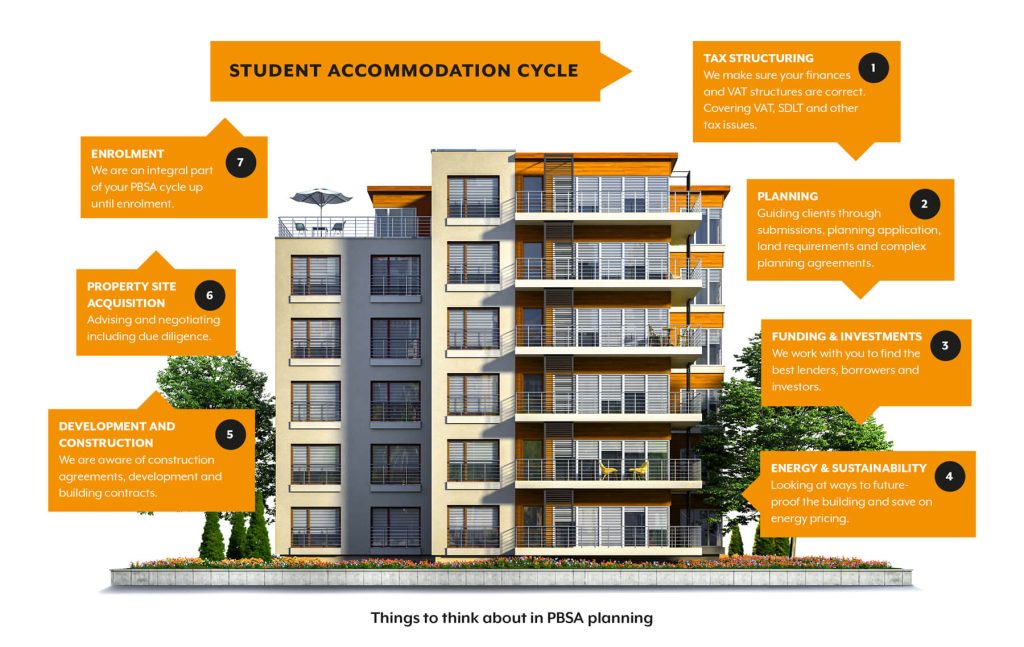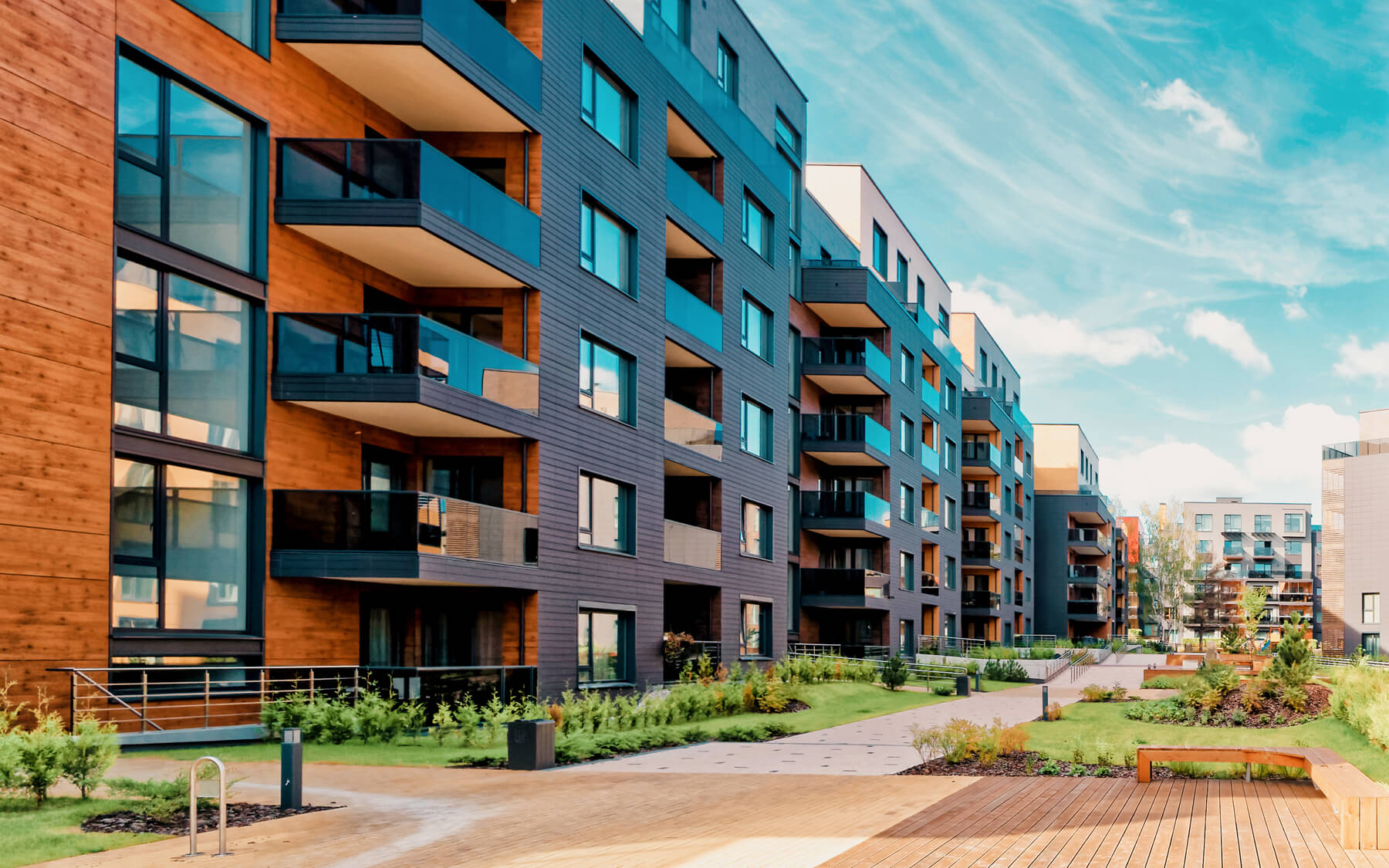Jason Appel
Head of Property and Construction, BKL
The demand for purpose-built student accommodation (PBSA) is increasing due to the rising number of international and domestic students pursuing higher education.
This trend looks set to continue. In 2021, for instance, the government’s international education strategy announced plans to grow international student numbers to at least 600,000 by 2030.
With PBSA providing a reliable source of rental income, it can be a profitable area for both investors and developers – but not without careful consideration and planning.
There are readily-available businesses who will willingly exit the properties once they’ve been built. This provides an abundance of long-term investors, pension schemes and REITs (real estate investment trusts), who retain a keen interest in PBSA because of the annuity value and a regular constant income.
This double benefit of demand on one side and the exit on the other differentiates PBSA from trying to sell in a traditional residential accommodation development, where developers are under pressure to manage or sell individual units.
If you’re a property developer or investor thinking of entering this field, you need to be experienced – or have access to experience. It’s a big undertaking. Planning alone can take a couple of years so you’d need equity behind you that covers that.
As well as compliance issues, there are numerous tax considerations and legal matters to take into account. To stay on course, you need to be well informed and prepared.
In this report, you’ll get insights into the PBSA marketplace and the range of factors to consider before embarking on your project.
Every property development within student accommodation has different structures, different stakeholders and different tax, legal and sustainability implications. For experienced developers, it is still proving to be an excellent market.
PBSA delivers undeniable benefits for students, such as guaranteed security and higher-quality living space. Usually taking the form of cluster flats or private studios, PBSA can offer fantastic leisure facilities such as fully equipped gyms, swimming pools, and games rooms.
Because of this, students – particularly international students – are more than happy to foot the bill for the experience. Much thought goes into the design of how the rooms work, how the kitchenettes work, and how the studios work. That must come through in the product, because students have the choice to live almost anywhere in their university town.
In many ways, PBSA is more than just bricks and mortar and much more than a temporary home for a year. Investors in PBSA are looking to take advantage of the demand that is driven by students choosing to relocate closer to leading universities and educational institutions throughout their time in higher education.
In terms of challenges, instability in the market is a big factor.
August and September 2022 are a case in point, when the Bank of England began its increasing of the base rate to help tackle inflation. Some developers who exchanged on large deals with interest rates and costs in mind will have seen those costs go up around 50%.
Things have settled back down but it won’t be as big a profit as they thought it would be. One of the benefits of the UK, though, is that it still has decent interest rates and a stable market, which makes investing in PBSA attractive.
What’s more, the success and potential of PBSA, how it’s structured and set up, provides opportunities to roll out the model post-student and across generations, from young professionals to retirees. Although the development of this model has had limited traction in the UK, it has succeeded in other European markets. The idea of taking people through their property and lifestyle lifecycle is yet another reason to consider getting into the PBSA space.
Overall, investing in PBSA development could prove to be a lucrative and wise investment choice.
Brotherton is a debt and equity advisory business with a property focus. Founded in 2014, the team have closed over £7bn of debt financings and raised in excess of £500m of equity in the UK and Europe.
The team have been involved in financing and raising equity for student accommodation developers for more than 15 years and have raised in excess of £1.5bn.
It may sound obvious, but being in the right student town and developing the right product for that town is far more important for PBSA than for many other property developments.
The student market is arguably the most transparent of all the real estate markets. It’s surprisingly easy (for developers and investors) to establish what other purpose-built accommodation there is; what the mix of beds in those is – for instance, if they’re studios or clusters or five-bedroom apartments or four-bedroom apartments. They can also straightforwardly establish what is being charged for those units as well.
All of the big agency firms track the planning applications for PBSA. So, as an investor or developer looking at a different market, it can be quickly established whether there’s a lot of supply already or if there’s not enough.
If there’s not enough supply, interested parties can also work out what type of accommodation is missing, be they studios or apartment flats or three-bedroom cluster flats. This gives a unique advantage to those wanting to enter the market: they can tailor their scheme to what they have proved will be best received in that particular area. Such an advantage is rare in the often opaque world of property and real estate.
A lot of information is publicly available, such as the number of students in particular cities. Data is also published by HESA (Higher Education Statistics Agency, now part of Jisc) about student numbers, where those students live, and how much of that is in university-provided accommodation.
So again, when developers and investors are looking into building this sort of accommodation, they can figure out the supply-demand much better than they can in a lot of other real estate.
While picking the right partner/developer is a key challenge to overcome, PBSA can be an amazing asset class compared to other commercial asset classes.
Take an office building or an industrial unit. That office building will typically be let for anywhere from 3 to 10 years. There might be several different leases but there is an agreement to a lease or rental income with that tenant for the next 3, 4 or 5 years.
Yes, there will be rent reviews, but typically those are just open market i.e., the tenant is paying £50,000 a year and in three years it is agreed that the rent should go up to £55,000. Some leases have RPI indexation but it’s very common for that RPI indexation to be capped and collared i.e. if RPI rises to 10% there will only be 4% rental inflation.
Residential and student accommodation assets offer inflation-linked annual uplifts, which is a potentially hugely attractive feature in the current environment.
Across the board, yields have increased, which means values have fallen. Residential and student accommodation are the two asset classes that have seen the least reduction in value proportional to interest rates.
Student accommodation and PBSA in particular have likewise benefited from the fact that it is still a relatively nascent industry and there is still an undersupply of PBSA accommodation assets in the UK.
PBSA as an asset class is similar to general residential property in that it is about places where people live. While the dynamics may differ, increasing demand for accommodation generally is often mirrored by increasing demand in the student market.
However, student accommodation has been given a privileged tax status and been exempted from some of the tax charges that apply to other sorts of residential accommodation. Although this is obviously good news, and helps to make PBSA an attractive asset class, investors must consider whether the tax benefits are factored into market prices for PBSA.

PBSA configured as dwellings is not exempted from the harsh rules relating to buy-to-let interest. Where an individual has a loan that funds the purchase of a dwelling which is let out, deduction for interest is given only at the rate of 20% while the rental income can be taxed at rates up to 45%.
This can be very unattractive where property is highly geared. This rule doesn’t apply to companies and can push geared investors towards buying PBSA configured as dwellings in a company rather than personally.
For developers, a key point is that the favourable tax treatment for PBSA should, in theory at least, mean that an investor is prepared to pay more for a PBSA building than a normal residential building generating the same rents (subject to adjustment for perceived differing risk).
Developers of PBSA will be taxed on their profits in much the same way as general residential developers. Another benefit of PBSA is that very large developers of residential property can be subject to the Residential Property Development Tax surcharge of 4%, but there is an exclusion for PBSA.
VAT: an important consideration
Where new-build student dwellings are developed for sale, the developer does not normally have to add VAT to the sale price but is nevertheless able to recover the input VAT it suffers (apart from certain blocked items). However, if the developer is building the PBSA to let out, rent is exempt for VAT purposes and doesn’t give rise to any right to recover input VAT. A strategy widely used to enable VAT recovery is for the developer to transfer the property or grant a lease internally, for example to a subsidiary.
In general, the VAT position for student accommodation that is configured as separate dwellings (as opposed to a hall of residence) is much the same as for other residential accommodation. However, to qualify as a dwelling for VAT purposes, certain conditions must be met – for example, that the dwelling is not subject to any restriction on its separate use and disposal. This can mean that some PBSA doesn’t qualify as dwellings for VAT purposes.
Relevant Residential Property
A PBSA building that doesn’t qualify as dwellings may still qualify as Relevant Residential Property (RRP). This is a VAT term that encompasses certain communal accommodation buildings used as the home of people that live there.
If the building qualifies as RRP, the same VAT treatment can be obtained. However, there are more conditions around RRP and the developer may have to obtain certificates from the buyer stating the intended use of the building.
ESG (environmental, social and governance) issues are increasingly important for the property industry and the development of PBSA is no exception. Sustainability credentials must be a part of that planning process.
Developers need to consider energy-efficient building designs, reduce carbon footprints and minimise energy bills for residents. The selection of construction materials should consider environmental impact, waste reduction, and recycling.
Developers need to consider energy-efficient building designs, reduce carbon footprints and minimise energy bills for residents. The selection of construction materials should consider environmental impact, waste reduction, and recycling.
Developers can develop systems within PBSA properties to reduce water usage, recycle water and deal with waste more sustainably. PBSA can provide a safe and secure environment for students. Developers should consider the location of properties, accessibility, and public transport links. Following the examples of businesses across many sectors, developers can ensure that their projects align with the UN Sustainable Development Goals (SDGs) and commit to clear ESG reporting and communication.
If developers create biodiversity loss from what they are proposing to build, they have to address that with a robust plan to replace biodiversity habitats in the location.
The growing value of ESG
Overall, there is a growing trend for investors to seek more sustainable assets, and developers need to consider ESG factors within their decision-making processes. ESG issues are becoming an increasingly important consideration for developers of PBSA, especially given the demand that students have for eco-friendly living spaces.
By balancing the ESG factors in their planning and design stages, developers can create properties that meet the needs of students, investors and the wider community.
Even though developers may be ticking ESG boxes now, they’ve also got to ensure that they are future-proofing that in 15 years.
The cost of maintaining a building is around 10 times the cost of building it. These are factors that are, sometimes literally, set in stone at the point that you build it. So you must plan upfront for the lifecycle of the building.
Changing practices now reduces cost, lowers maintenance costs and empty construction costs, and stops the building from suddenly falling foul of legislation because it’s already thinking about being circular from the beginning.
At the moment, we don’t build the value of a sustainable building into the valuation practices. We don’t ask how much it’s going to cost to maintain this building or whether it’s going to become a stranded asset. If that happens, the costs outweigh the benefits and no one will want to invest or indeed live there. What are the hidden aspects of ESG that are not captured at the moment in the valuation process?
A green building is both a necessity and a selling point but there is already talk about the fact that if, in five years, a building doesn’t have an ESG plan attached to it, it won’t be able to get any funding at all. It’s therefore essential to be factoring a current understanding of ESG into your PBSA planning process.




